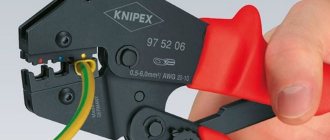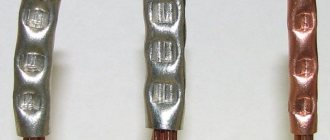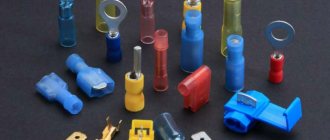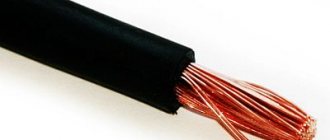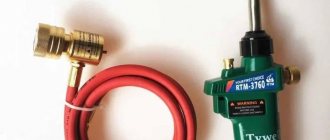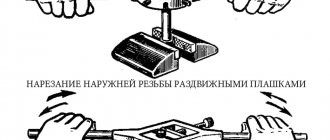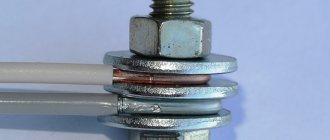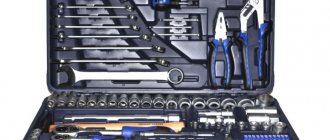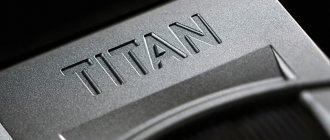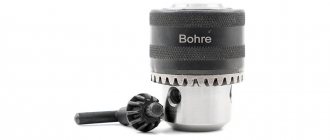There are many ways to connect wires - from the old-fashioned twisting to the most modern self-clamping terminal blocks. But none of them is ideal; each method has its own advantages and disadvantages. In some cases, it is enough to connect the wires in the terminal block; sometimes welding or soldering will be necessary. But there are times when crimping the wires is the best option; we’ll talk about it in more detail.
Crimping technology
There are two methods by which crimping is carried out:
- local indentation;
- complete compression.
The wire for crimping is copper or aluminum. Therefore, the sleeve can be either copper or aluminum. There is also copper-aluminium. Since an aluminum cable is prone to the formation of an oxidizing film, the aluminum sleeve must be cleanable and treated with a special lubricant. To protect aluminum from oxides, quartz vaseline paste is used. Copper wire is also subject to lubricant treatment. With its help, the likelihood of damage to the core during crimping is reduced and friction is reduced.
If the cores are multi-wire, they are aligned and folded so that they easily fit into the sleeve; you can twist the wires a little. Then the cable is inserted into the cartridge until it stops. The connection can be made not end-to-end, but, for example, with a factory. Then the total cross-section of all wires should not exceed the cross-section of the bushing.
In any case, sleeves are used that are designed for the total cross-section of the cores being crimped. If a press with point (local) indentation is used, make 2-3 pressings evenly distributed along the length of the sleeve to ensure mechanical strength of the connection and good electrical contact. For continuous crimping using hexagonal or square dies, the recommendations are essentially the same
In both cases, it is important that the sleeve does not crack during crimping (if it is too small) and that there are no uncompressed areas or cavities (if it is too large)
After the crimping has been carried out, it is necessary to create an outer insulating layer at the junction using electrical tape or elbow cloth. After insulation, you should carefully fold the wires and the cable itself in the junction box.
The video below clearly shows how to crimp wires with press pliers:
Advantages and disadvantages
There are many positive aspects to crimping:
- The tool used to make this connection is hand-held and does not require electricity to operate. In cases where you have to work in a room where there is no voltage, crimping is the only high-quality connection method.
- Using crimping tubes, you can connect conductors from different metals, which is a solution to the eternal problem of switching copper and aluminum conductors in one electrical unit.
- If welding requires a specialist capable of performing welding work, and when soldering it is necessary to be able to use a soldering iron, then anyone can do crimping; you just need to try the press pliers in action once.
- Using a special crimping tool, it is possible to make connections in any, even limited spaces. It is especially convenient when connecting wires in a socket box or box.
- Crimping with press pliers and sleeves allows you to shorten the connected sections of wires to a minimum.
- Due to mechanical force, the most durable contact connection is created.
- As a result of crimping, a permanent connection is obtained that can withstand heavy physical stress when breaking.
- Installation speed is minimal, connection quality is maximum.
- This contact does not require any maintenance.
The one-piece type of crimping is in some way a disadvantage, that is, if necessary, it is impossible to unscrew the connection and replace one of the conductors. The sleeve can only be cut out.
How to connect electrical wires with lugs
Another way is to use tips. The tip looks like a piece of tube, cut and turned flat on one side. A hole for a bolt is drilled in the flat part. The lugs allow you to connect cables of any diameter in any combination. If it is necessary to connect a copper cable to an aluminum cable, special lugs are used, in which one part is copper and the other is aluminum. It is also possible to place a washer, brass or tinned copper, between the tips.
The ferrule is pressed onto the cable using a crimper, similar to how wires are connected using crimping.
How to brew twist
For good contact, the twist can be welded with a graphite electrode or a gas torch. Torch welding has not become widespread due to the complexity and the need to use gas and oxygen cylinders, so this article only talks about electric welding.
Electric welding is performed using a graphite or carbon electrode. Graphite electrode is preferable. It is cheaper and provides better welding quality. Instead of a purchased electrode, you can use a rod from a battery or a brush from an electric motor. It is better not to use copper electrodes. They often get stuck.
For welding, you first need to make a twist 100 mm long, so that the finished one turns out to be about 50. The protruding wires need to be trimmed. For welding, it is best to use an inverter welding machine with adjustable current. If this is not the case, then you can take a regular transformer with a power of at least 600 W and a voltage of 12–24 V.
Near the insulation, “ground” or “minus” is connected using a thick copper clamp. If you simply wrap a wire around a twist, the twist will overheat and melt the insulation.
Before starting welding, it is necessary to select the current. The required current varies depending on the number and thickness of the wire that makes up the twist. The welding duration should be no more than 2 seconds. If necessary, welding can be repeated. If everything was done correctly, then a neat ball will appear at the end of the twist, soldered to all the wires.
Tip sizes, design features
The minimum available sections for GML are 1.5 mm 2. Further sizes increase - 2, 4, 6, 10 mm 2 and higher. Based on these values, we can say that the cross-sections of the sleeves are equal to those of wires and cables. It is quite easy to decipher the tip designations. For example, GML-6 is a copper tip, tinned. The cross-section is 6 mm 2. In the case of combined sleeves, the marking indicates two sizes - for aluminum wire and for copper. For example, GAM 16/10 - 16 for aluminum, and 10 for copper.
By design, the sleeves can be end-to-end in the form of a hollow tube or with a partition. The latter are used when crimping wires with end-to-end lugs is performed. These partitions are located in the middle of the sleeve. With their help you can adjust the depth of the cable entry. If it is necessary to extend it, then both ends will go into the tip to the same length.
Video description
The use of crimping pliers and strippers is described and shown in this video:
On a note! A wide range of tools allows you to purchase a suitable crimp for wires in accordance with their diameter, the lugs used, and the planned amount of work.
Although the most common are press pliers, the operating principle of which is similar to the functioning of pliers, electricians also use a diaphragm tool in their work. Its special feature is the ability to perform crimping on 4 or even 6 sides. The exact number of such surfaces is influenced by the type of diaphragm that is installed in the jaws.
The full-circle tool sleeve increases the reliability of the connection. Crimping of cable lugs is performed with maximum density. In addition, there is no need for the tool to change the bushing because the tool is able to automatically adjust to its thickness.
Diaphragm tool Source ls-market.ru
However, there is a drawback to diaphragm clamps. Using such a tool, crimping is performed exclusively on the end of one cable. The reason for this is the presence of a closed head located on the other side of the hole into which the tip is inserted. Therefore, such a tool is not used to crimp 2 electrical cables. In other words, it is not used instead of twisting.
Principle of wire crimping
You can perform crimping of wires using sleeves in several ways. It will not be possible to single out the best of them, since comparison is inappropriate here. The choice of crimping method directly depends on the conditions for electrical installation work, cross-sectional parameters and other important points. Let's consider the features of the main method of crimping using sleeves.
Work begins by introducing the previously stripped ends of the wires into the cavity of the sleeve. The next step is crimping - squeezing using a special tool. The metal surface of the cores and sleeve is compressed, resulting in a reliable adhesion of the parts. It is necessary to connect at several points, followed by insulation of the connection points. An exception is working with insulated sleeves for crimping, which do not require additional insulation.
When choosing this method of connecting wires, you need to remember that the contact will not be disconnected in the future. Taking this into account, work will need to be carried out carefully and prudently.
Main types of ticks
Ferrule crimper
Crimping pliers are divided into two types. The most common type is a design that works like pliers. That is, the sleeve is compressed on both sides. Other pliers are diaphragm crimpers.
Crimping pliers
Passatizhny
The tip is crimped in the same way as pliers grip a part. The working surface of the dies has cutouts into which the tip shank is threaded. This design is suitable for those fastenings that do not require special reliability.
To increase crimping force, hydraulic ferrule crimping tools were invented. Thanks to this improvement, the pliers became more efficient. The design uses cylinders with pistons filled with oil, which creates a large pressure of the matrices on the tip sleeve.
Pliers with removable dies
Important! Some crimpers are equipped with several types of removable matrices. The versatility of the tool eliminates the need for pliers for each conductor cross-sectional size.
Diaphragm pliers
The originality of the design of diaphragm crimpers lies in the comprehensive coverage of the tip shank. The principle of operation is similar to the movement of the aperture blades of photographic lenses. The only drawback of such devices is the impossibility of inserting pliers into the connection of the two ends of the wires.
Note! The diaphragm tool is used as a press for pin or flat metal tips. The all-round clamp is much more effective than the plier type for covering the end switches of wire products.
Diaphragm pliers
The main points of the process of crimping wires and twists
To do this, you will need to strip the wire from the outer insulation, and then use a mounting knife to remove the inner protective sheath. To make it convenient to twist the wires, I personally collect the bare wires into a bundle and bend the ends.
Then, first twisting the wires by hand, I achieve greater contact through the work of the pliers with which I tighten the twist.
Having bitten off the excess wires with the same tool, I get a good connection 3-5 cm long.
Next, the only thing left to do is put copper sleeves of suitable sizes on the twists and crimp them. Moreover, crimps come in different diameters (6 mm, 8 mm, 10 mm and more). Usually, I use 6 mm products to connect strands of light groups, where the cross-section of the wires is not so large (1.5 sq. mm). For socket groups, sleeves with a diameter of 8 mm or more are taken, since here the wires have a cross-section from 2.5 to 4 sq. mm.
After that, I insulate the connections, put them in the junction box and close the lid so that everything is “feng shui”.
Subtleties of the process
Regardless of how and what you use to weld stainless steel, you must follow the following rules that will help you obtain a high-quality connection:
- Prepare in advance the liquid that you will use to cool the surface upon completion of the work.
- Ampere characteristics should be 20% lower compared to welding other types of steel.
- During the joining process, control the gap size due to the high linear expansion of the alloy.
- The length of the electrodes used should not exceed 350 mm, due to the high resistance of stainless steel.
If you neglect even one point, the risk of a weld defect will be very high.
Common mistakes when crimping
Cutting shells
At first glance, they are long. People who do not have the necessary knowledge and experience believe that using the entire cartridge case is wasteful, and cut it into pieces. This leads to a reduction in the length of the section where the conductors are bonded. The result is that the mechanical strength of the contact suffers, since working with pliers becomes inconvenient, and the number of pressure points decreases.
Wrong choice of sleeve diameter
If it is larger than required, then it is unlikely that it will be possible to produce high-quality crimping. The only way out is to bend the tip of the wire and then insert it into the sleeve. But such crimping is only suitable for “copper”, but the strength of the connection becomes lower. Aluminum wire breaks easily, so it is not an option.
With a smaller sleeve diameter, people without experience try to “plant” the ends of the wires into it by sharpening them a little. This is absolutely forbidden to do! Reducing the cross-section in a particular area leads to overheating and destruction of the metal. By the way, this often causes inflammation. It remains to add that the contact strength also decreases.
Crimping with pliers
Press jaws are specially designed for this specific job. Crimping with pliers is fraught with the fact that the conductor is deformed, and quite significant. After all, with this connection method it is impossible to control the clamping force. The consequences of reducing the cross-section of the core are indicated above.
Some craftsmen do crimping exactly this way, while assuring that everything is “acceptable.” But this does not mean that this technique is correct. The author came across such a situation and asked the unfortunate master a question: if he needs to do crimping at home, will he also work with pliers? As expected, there was no clear answer.
Useful tips
- It is not always possible to select a sleeve so that after placing the ends of the conductors in it, there are no voids left. The more free space, the higher the risk of poor contact after crimping it. How to proceed? The easiest way out of the situation is to cut pieces of wire (bare) with a length slightly shorter than that of the sleeve, and “hammer” them into it. Such artificial compaction will significantly improve the quality of crimping.
- If the connection of wires is made to extend the line, then their joint should be located in the center of the sleeve.
- When insulating the joint, the tape (tube) must extend beyond the sleeve cuts by at least 10 mm.
- In the case when at least one of the wires is multi-core, or different numbers of them are spliced on both sides, not metal sleeves are used for crimping, but insulated lugs (NSHVI).
It turns out that there is nothing complicated about crimping with sleeves. The main thing is to choose the right size. If the reader takes into account the recommendations given, then it is quite possible to cope with such work on your own. Good luck!
Connection Features
The technology involves two options for crimping. This is a method of local indentation and continuous compression. Copper or aluminum wires are used for work. The sleeve must also be made of these materials. There are also elements made of copper-aluminum alloy.
Since aluminum cables are prone to the appearance of oxidative films on them, the sleeve must first be cleaned and treated with special lubricants. Copper wires are also pre-treated. The use of lubricants in the process reduces the risk of possible damage to the cores. The friction force is also noticeably reduced. Pressure testing is carried out using manual or hydraulic tools. In the latter case - with a figure press. It is usually used in large industries.
How it works? The two ends of the cable are crimped until they take a round shape. Next, the core is inserted into the sleeve until it stops. It is possible to connect not exactly end-to-end. But in this case, the cross-section of all cores does not exceed the bushing. In the case of local compression, contact directly depends on the depth of the pits. The latter can be measured with a caliper. If continuous compression is used, then check the cross-sectional area. Then, when the crimping of the wires is completed successfully, it is necessary to treat the outer layer with electrical tape or elbow cloth. Next, the wire and cable are carefully laid in the junction box.
Tools and materials
To work, you will need manual (or mechanical) press pliers. They crimp a sleeve with conductors with a cross section of up to 120 mm2. For conductors with a larger cross-section, a press is required, which is driven by a hydraulic drive.
There are pliers with dies for different sections and with adjustment of the punches. A very convenient tool in the sense that you don’t have to constantly reset it to other sizes, just turn the punch screw or matrix to the desired section.
When working with aluminum wires, you will need a special quartz-vaseline paste, which removes the oxide film on the wires and prevents its reappearance.
Copper conductors do not need such treatment, but it is still advisable to lubricate them with ordinary technical petroleum jelly to reduce friction. During deformation, the cores can be damaged, and lubricant minimizes this risk.
Types of connecting tubes
Crimping of wires can be carried out using connecting sleeves in several designs. The choice of connecting tube will depend on the electrochemical properties of the metal from which it is made and its interaction with the material of the wire.
There are several options for materials for the manufacture of sleeves:
- copper;
- tinned;
- combined universal;
- isolated.
Copper tubes (CM) are used for copper wires, the crimping of which cannot damage the protective layer due to its absence. The tubes cannot be used in aggressive environments.
Tinned sleeves (GML) are suitable for copper type cables used in aggressive conditions. The white protective layer covering the surface of the product fully copes with the main functions. The tubes are not suitable for working with aluminum wires due to possible contact of the protective layer, which is partially destroyed during compression, with aluminum.
Combined wire sleeves have a distinctive feature - their shape. The aluminum part is larger than the copper part. This is due to the resistance of aluminum, which exceeds the resistance of copper. During the crimping process using such tubes, wires are inserted on each side, taking into account the type of metal.
The last option for sleeves is insulated (GSI). They replace additional insulation with PVC tapes due to the presence of heat-shrinkable tubing. Their structure is similar to the structure of GML tubes, with the exception of a PVC layer that does not transmit electricity. The protective layer is quite plastic and reliable, indestructible even during the crimping process, taking the shape of a metal.
What is the essence of the method?
Crimping is a method of connecting wires using special sleeves. Outwardly, they look like ordinary tubes and serve as a connecting mechanism.
The wire strands that are to be connected are inserted into the tube from two opposite ends, crimped with press pliers, and as a result, a strong and reliable electrical unit is obtained. The tube is compressed in two or three places, depending on its length and the cross-section of the switched conductors. The connected cores and the sleeve are jointly subjected to deformation. At this moment, the tube compresses and squeezes the conductive surfaces of the conductors. Due to this, the wires interlock with each other, which provides reliable electrical contact.
The junction is then isolated.
Most often, this method is used in situations where it is not possible to use another type of connection. For example, welding requires the presence of electricity so that the welding machine can be connected. When working in a small junction box, it is inconvenient to position the bolt connection, nut clamp or terminal block. And reaching up to the distribution box from the ceiling with a soldering iron is also not very convenient. It is in such cases that crimping wires using sleeves helps out.
The crimping method is most in demand:
- if it is necessary to connect wires in power lines with a high current load;
- for switching multi-core conductors;
- if it is necessary to connect large cross-section wires.
This is interesting: How to choose a cable channel for electrical wiring: let's look carefully
What is crimping with sleeves?
The essence of crimping is that electrical wires or cables are connected using conductive sleeves, which are tubes made of metal. The process of crimping cables, as a result of which a strong and reliable electrical connection is created, is as follows:
- The cores of the electrical wires, previously stripped of insulation, are inserted into the inner part of the crimp tube at both ends and must be connected.
- Using special press pliers or ordinary pliers, crimp the sleeve around the conductor placed in it. For higher reliability, the tube is crimped in two or three places.
- The place where the crimping is performed is isolated using TUT or electrical tape made of PVC for this purpose. If connection sleeves covered with a layer of insulation are used for crimping, there is no need for additional insulation of the formed connection.
Stages of crimping an electrical wire with a sleeve
Crimping wires with sleeves is especially relevant in the following situations:
- when connecting elements of electrical networks operated under high load;
- when connecting wires with a large cross-section;
- in cases where it is not possible to connect the wires in any other way (in particular, this method is used to connect wires in a junction box in which it is quite difficult to mount a terminal block;
- In addition, crimping sleeves are used to connect wires located at high altitudes or in conditions of limited visibility).
Crimping of wires with sleeves ensures excellent electrical contact and high mechanical strength of the connection
Let us list the most significant advantages of connecting wires by crimping.
- The tool for crimping wires, which is mainly used as press pliers, does not need to be connected to an electrical network, which distinguishes it favorably from electrical devices with which wires are connected by soldering. Thus, crimping (or sleeve, as this process is also often called) is practically the only possible way to form a high-quality connection of wires in places where there is no possibility of connecting the tool used to the electrical network.
- To connect wires using the crimping method, special knowledge and skills are not required. This cannot be said, for example, about soldering, which is unlikely to be done efficiently without the appropriate skills and experience.
- Using a special tool for crimping sleeves, you can create high-quality wire connections even in hard-to-reach places, such as distribution boxes and socket boxes. Moreover, the use of the crimping method for connecting wires in socket boxes makes it possible to reduce the length of the connected contacts to a minimum, which makes it possible to increase the density of the electrical installation performed.
An important advantage of using crimping is that using this method you can successfully connect wires whose cores are made of different metals. The same soldering cannot achieve this.
Twist connection
The easiest way to connect wires is twisting. Previously, this was the most common method, especially when wiring in a residential building. Now, according to the PUE, connecting wires in this way is prohibited. The twist must be soldered, welded or crimped. However, these methods of connecting wires begin with twisting.
In order to perform high-quality twisting, the connected wires must be cleared of insulation to the required length. It ranges from 5 mm when connecting wires for headphones to 50 mm if it is necessary to connect wires with a cross-section of 2.5 mm². Thicker wires are usually not twisted together due to their high rigidity.
The wires are stripped with a sharp knife, insulation stripping pliers (ISR) or, after heating with a soldering iron or lighter, the insulation is easily removed with pliers or side cutters. For better contact, bare areas are cleaned with sandpaper. If the twist is supposed to be soldered, then it is better to tin the wires. Wires are tinned only with rosin and similar fluxes. This cannot be done with acid - it corrodes the wire and it begins to break at the soldering site. Even washing the soldering area in a soda solution doesn’t help. Acid vapors penetrate under the insulation and destroy the metal.
The stripped ends are folded parallel into one bundle. The ends are aligned together, the isolated part is held firmly with your hand, and the entire bundle is twisted with pliers. After this, the twist is soldered or welded.
If there is a need to connect the wires to increase the total length, then they are folded opposite each other. The cleaned areas are placed crosswise on top of each other, twisted together by hand and tightened tightly with two pliers.
You can only twist wire made of the same metal (copper with copper, and aluminum with aluminum) and of the same cross-section. Twisting wires of different sections will turn out uneven and will not provide good contact and mechanical strength. Even if it is soldered or crimped, these types of wire connections will not ensure good contact.
Standard crimping errors
There are several typical mistakes that novice electricians or those who carry out the core crimping process themselves make. For example:
- The used sleeve has a cross-section smaller than the wire. There is never any need to reduce the cross-section of the cores and adjust it to the diameter of the sleeve. This leads to an increase in resistance and a decrease in throughput. Where there was a combination, the vein will heat up and collapse.
- Large size sleeve. If the socket is used with a large diameter, it will not bring a strong and reliable connection. Even if you bend the wire several times, this will not lead to good performance, since the mechanical strength will drop by almost half.
- Cutting the sleeve into several parts. When crimping a cable with a short length of exposed ends, it is inconvenient to work with pliers, and the contact area is reduced.
- Crimping should be carried out exclusively using press jaws. Special tools were invented for this joining method. Therefore, you should not use pliers or a hammer, as this can damage both the sleeve and the cable. To prevent this from happening, it is necessary to use a tool such as press pliers, as they greatly simplify the work of crimping cable connections.
That's all I wanted to tell you about how wires are crimped with sleeves. We hope the information provided was useful and interesting for you!
You probably don't know:
- Methods for connecting LED strip
- Which electrical tape is best for electrical wiring?
- How to find a junction box in a wall
Features of the tool for crimping electrical wires
Crimping of wire lugs is carried out with a special tool. It is selected for the specific type of product being clamped. After all, it can not only be flat, but also have the shape:
- cylinder;
- forks;
- loops;
- knife,
- plug.
Tips are available in different shapes Source elektroznatok.ru
When choosing a tool, the crimping range is also taken into account. This is a parameter that shows the largest and smallest cross-section of the electrical cable. If a wire with a diameter of 0.25-16 mm is crimped, then crimping is done using hand pliers. Such a tool is used, for example, during the installation of low-current, telephone, and computer lines.
Hydraulic pliers are used when connecting substations when large-diameter cables are laid. Their cross-sectional area usually exceeds 16 mm². If a large amount of work is being done, professional electricians use electric pliers. They can operate in semi-automatic or fully automatic mode.
Hydraulic powerful press jaws Source avtomag96.ru
Wire crimping: common mistakes
Many novice electricians or people who do not have information in the field of electrical installation often make a number of mistakes that affect the subsequent operation of the entire electrical circuit.
Pressure testing can be carried out using sleeves or tips
Installation errors:
- The sleeve cross-section is smaller than the cable cross-section;
- Sleeve of larger cross-section;
- Saving;
- Crimping without using pliers.
When purchasing crimps (sleeves), many do not take into account such an important factor as the cable cross-section. Therefore, after purchasing a crimp sleeve or sleeves, it turns out that its cross-section is smaller than the cross-section of the wire.
The main mistake that is made in this case is reducing the cross-sectional area of the cable, which is completely unacceptable. This is due to the fact that at the junction of the wires, resistance increases, which leads to heating of the wires during operation. And if a device with higher power is connected to this network, the wire may simply burn out and lead to a short circuit.
The use of sleeves with a large cross-section will not allow achieving high-quality and reliable contact
It is important to understand that with this connection, the mechanical strength also decreases
In order to save on connecting elements, many divide one sleeve into several parts, thereby increasing the resistance accordingly.
The rules stipulate that crimping of sleeves must be done only with a special tool in the form of press pliers. Therefore, a hammer or pliers are completely unsuitable for this job.
This is due to the fact that using a hammer can damage the sleeve, and compressing the sleeve with pliers is not enough for good contact.
Additional recommendations
For proper crimping, you must use the following tips:
- Make the junction of the conductors in the center of the connecting tube.
- Select the correct sleeve section. There will be fewer voids inside the clutch, and contact will become more reliable.
- Apply the insulation so that it extends 1 cm beyond the connecting tube on both sides.
- Use ferrules if cables with different numbers of cores are spliced.
Crimping is a procedure that allows you to obtain maximum adhesion of conductors when installing electrical networks. However, to carry it out correctly, the appropriate tools and materials are required.
Classification by material of manufacture
One of the main parameters, depending on which wire sleeves are divided into different types, is the material of their manufacture. The need to use dissimilar sleeves is determined by differences in the electrochemical properties of the connected wires made of different metals. So, if an inappropriate sleeve is chosen to connect wires made of a certain metal, the place of the formed contact will oxidize, which over time will lead to a decrease in its reliability in terms of electrical conductivity.
The main types of sleeves for crimping electrical wires, depending on the material from which such tubes are made, are:
- copper sleeves;
- tinned connecting sleeves;
- combined;
- isolated.
Copper
A copper sleeve, which is marked GM, is needed for crimping wires also made of copper. Taking into account the fact that the copper sleeve does not have a protective coating, it can only be used to connect wires operated in a non-aggressive environment. If you neglect this requirement, the copper sleeve will quickly oxidize and cease to perform its functions.
Copper cable sleeves must be made from copper tubes of grades M1 or M2
Tinned
To connect electrical wires operated in an aggressive environment, tinned copper sleeves for crimping are used, which are marked GML. In order to protect the main material of their manufacture - copper - from electrochemical corrosion, GML sleeves are coated with a special compound.
This is explained by the fact that part of the protective coating of such a tube is destroyed when it is compressed, which will lead to contact between aluminum and copper and, accordingly, to the development of electrochemical corrosion.
Connecting sleeves type GML, made of electrical copper with a tin-bismuth protective coating
Combined
Quite often, when installing electrical networks, it becomes necessary to connect wires whose cores are made of different metals. To solve such problems, combined type sleeves have been specially developed and are successfully used. The design feature of such crimp tubes, which are marked GAM, is that one half of them is an aluminum connecting sleeve, and the second is made of copper. At the junction of two such tubes, which are connected to each other by welding, there is a special limiter. It is necessary in order to prevent contact of two dissimilar wires inside the sleeve itself.
Adapter cable sleeve aluminum-copper 16/10 sq. mm
Another design feature of combined crimp tubes is that the part of them, which is the aluminum connecting sleeve, has a larger diameter than the tube intended for copper cables. This design feature is explained by the fact that aluminum, when compared with copper, has greater electrical resistance, therefore the wire made from it, which will be connected to the same electrical network with a copper conductor, must have a larger diameter.
The crimping itself using combined sleeve clamps is performed according to the same algorithm as the procedure with sleeves of any other type. However, it is necessary to carefully ensure that dissimilar wires are inserted into a tube of the appropriate metal.
Isolated
Among the crimping tubes used for crimping electrical wires, the category of insulated connecting sleeves is distinguished. The use of the latter eliminates the need to perform additional insulation of the contact area formed with their help. In terms of their design, insulated sleeves are the same tinned copper tubes, the outer surface of which is covered with an insulating layer of fairly durable and at the same time plastic PVC. Due to the mechanical properties of such a protective layer, sleeves of this type can be successfully crimped without compromising their original characteristics.
Fully insulated connection sleeves
Insulated sleeves for hermetically sealed connection of SIP wire cores
Video description
The master talks about the features of using hydraulic press tongs in this video:
Tool for sequential crimping of cable products
This type of crimper allows you to prevent air from entering the inner cavity of the sleeve during crimping. This nuance is very important when connecting an aluminum cable to a copper wire. The absence of air reduces the likelihood of oxidation at the point of contact between two metals.
Computer wire crimping pliers
Twisted pair cable is used to connect a computer to the Internet. Special crimpers are used for the LAN cable. This type of tool belongs to a separate group of press jaws. Their design has a special matrix, which differs in shape. It is this that allows the installation of RJ 45 type plugs. It is also used during the installation of telephone networks.
This type of crimper does not crimp. The tool displaces contacts that cut through the insulation protection on each thin twisted pair conductor.
Professional crimping of computer wire Source stroy-okey.ru
How to connect electrical wires by soldering
Connecting electrical wires by soldering is very reliable. You can solder untwisted wires, but such soldering will be fragile due to the fact that the solder is a very soft metal. In addition, it is very difficult to lay two conductors parallel to each other, especially when suspended. And if you solder on some kind of base, the rosin will stick the soldering area to it.
A layer of rosin is applied to the pre-tinned and twisted conductors with a soldering iron. If another flux is used, it is applied in the appropriate manner. The power of the soldering iron is selected based on the cross-section of the wire - from 15 W when soldering headphones to 100 W when soldering twisted wires with a cross-section of 2.5 mm². After applying the flux, tin is applied to the twist with a soldering iron and heated until the solder completely melts and flows into the twist.
After the soldering has cooled, it is insulated with electrical tape or a piece of heat-shrinkable tubing is put on it and heated with a hairdryer, lighter or soldering iron.
When using a lighter or soldering iron, be careful not to overheat the heat shrink.
This method reliably connects wires, but is only suitable for thin wires, no more than 0.5 mm², or flexible ones up to 2.5 mm².
Terminal block connection
A development of the bolted connection is the terminal connection. Terminal blocks come in two types - with a rectangular pressure washer and with a round one. When using a terminal block with a pressure washer, the insulation is removed to a length equal to half the width of the terminal block. The bolt is released, the wire is slipped under the washer and the bolt is clamped again. On one side, you can connect only two wires, preferably of the same cross-section and only flexible or only single-core.
Connecting to a terminal block with a round washer is no different from using a bolted connection.
The connection of the wires is reliable, but cumbersome. When connecting wires with a cross-section of more than 16 mm², the connection is unreliable or the use of lugs is necessary.
How to connect wires by crimping
Another way to connect wires is crimping. This is a method in which a copper or aluminum sleeve is placed on the wires or cables to be connected, and then crimped with a special crimper. For thin sleeves, a manual crimper is used, and for thick ones, a hydraulic one is used. This method can even connect copper and aluminum wires, which is unacceptable with a bolted connection.
To connect using this method, the cable is stripped to a length greater than the length of the sleeve, so that after putting on the sleeve, the wire sticks out 10–15 mm. If thin conductors are connected by crimping, then twisting can be done first. If the cable has a large cross-section, then, on the contrary, in the stripped areas it is necessary to align the wire, fold all the cables together and give them a round shape. Depending on local conditions, the cables can be folded with the ends in one direction or in the opposite direction. This does not affect the reliability of the connection.
A sleeve is tightly placed on the prepared cables or, when laid in opposite directions, the wires are inserted into the sleeve from both sides. If there is still free space in the sleeve, it is filled with pieces of copper or aluminum wire. And if the cables do not fit in the sleeve, then a few wires (5–7%) can be cut off with side cutters. If you do not have a sleeve of the required size, you can take a cable lug by sawing off a flat part from it.
The sleeve is pressed 2–3 times along its length. The crimping points should not be located at the edges of the sleeve. It is necessary to retreat 7–10 mm from them so as not to crush the wire during crimping.
The advantage of this method is that it allows you to connect wires of different sections and from different materials, which is difficult with other connection methods.
How to choose the right crimp sleeve by diameter
Crimping sleeves can be used equally successfully to make a high-quality connection of both single-core and multi-core electrical or network cables. When choosing such a sleeve for a mono- or multi-core, you should take into account not only the material of manufacture, but also the diameter of the connected conductors. To correctly select crimp sleeves according to the diameter of the wires being connected, it is best to use special reference tables.
Technical dimensions of the sleeve for crimping wires, taken into account during selection
Table 1. Parameters of GM sleeves and recommended tools for crimping
The quality of the electrical contact created directly depends on how correctly the crimp tubes are selected according to the diameter of the wires being connected. So, if the diameter of the wires that need to be connected is greater than the inner diameter of the sleeve itself, then the conductor cannot be placed in the inner part of the tube. Situations where the inner diameter of the sleeve is much larger than the outer diameter of the wires being connected are also undesirable. In such cases, the crimped wires, located in the inner part of the tube with a significant gap, will create a poor-quality contact.
When selecting a crimp sleeve for connecting wires of a certain diameter, you can be guided by a simple rule: the conductor placed inside the sleeve must sit tightly in it, without dangling.
Table 2. How many wires fit in one connector
It is also possible to qualitatively connect wires using a sleeve, the internal diameter of which significantly exceeds the cross-sectional size of the conductor itself. To do this, they use a simple technique: the wire is inserted into the sleeve, after which the gap that has formed between the walls of the connecting tube and the surface of the conductor is tightly clogged with pieces of strands from a wire made of the same metal. After performing this procedure, the sleeve is crimped using standard technology.
